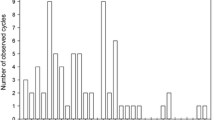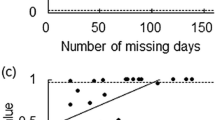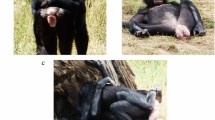Abstract
Recent findings suggest that menstrual synchrony may occur in humans and is more dependent on factors of close personal association than simple prox imity. Part I of this study analyzed the estrous cycles of 10 captive group living chimpanzees (Pan troglodytes) housed in two separate groups in the same building. Each group contained at least one male. The mean discrepan cies for (1) the approximate day of ovulation (last day of maximum swelling) and (2) the day of onset of estrous swelling were determined for all possible pairs within groups and compared to the mean discrepancies of pairs between groups. With respect to the probable day of ovulation, the mean discrepancy of animals caged together was 8.0 days and that of animals caged separately was 10. 7 days. Comparing the onset of estrous swelling, the mean between groups was 10.4 days, whereas females caged together averaged only 5.7 days. A repeated-measures analysis of variance indicated a significant group effect in the onset of estrous swelling (F = 5.68,p < 0.05), whereas there was no significant difference between the animals caged together and those caged separately with respect to the last day of maximum swelling (F = 1.37, NS). Part II of the study compared the onset of the first postpar tum estrus (PPE) to the onset of estrus in cagemates. During a 6-year period, 13 females exhibited 33 PPEs while in social contact with cycling females. Of 86 paired comparisons, the PPE onset of 43 (50%) occurred with in 6 days of the swelling onset of a cagemate. The results suggest that, as in other species (including humans), the social contact and time spent together influence the synchrony of chimpanzee estrous cycles, especially in terms of swelling onset. The synchrony of estrous swelling and possible mediation by olfactory and/or hormonal cues are discussed as they relate to chimpanzee social structure and female reproductive strategy.
Similar content being viewed by others
References
Anand Kumar, T. C., David, G. F. X., Umberkoman, B., and Sain, K. D. (1974). Uptake of radioactivity by body fluids and tissues in rhesus monkeys after intravenous injection or intranasal spray of tritium-labelled oestradiol and progesterone.Cur. Sci. 43: 435–439.
Bailey, J., and Marshall, J. (1970). The relationship of the postovulatory phase of the menstrual cycle to total cycle length.J. Biosoc. Sci. 2: 123–132.
Bonsall, R. W., and Michael, R. P. (1971). Volatile constituents of primate vaginal secretions.J. Reprod. Fertil. 27: 478–479.
Coe, C. L., Connolly, A. G., Kraemer, H. C., and Levine, S. (1979). Reproductive development and behavior of captive female chimpanzees.Primates 20: 571–582.
David, G. F. X., Puri, C. P., and Anand Kumar, T. C. (1981). Bioavailability of progesterone enhanced by intranasal spraying.Experientia 37: 533–534.
Doty, R. L., Ford, M., Preti, G., and Huggins, G. R. (1975). Changes in the intensity and pleasantness of human vaginal odors during the menstrual cycle.Science 190: 1316–1317.
Doty, R. L., Snyder, P. J., Huggins, G. R., and Lowry, L. D. (1981). Endocrine, cardiovascular, and psychological correlates of olfactory sensitivity changes during the human menstrual cycle.J. Comp. Physiol. Psychol. 95: 45–60.
Dunbar, R. I. M. (1980a). Determinants and evolutionary consequences of dominance among female gelada baboons.Behav. Ecol. Sociobiol. 7: 253–265.
Dunbar, R. I. M. (1980b). Demographic and life-history variables of a population of gelada baboons (Theropithecus geladá).J. Anim. Ecol. 49: 485–506.
Elder, J. H. (1983). The time of ovulation in chimpanzees.Yale J. Biol. Med. 10: 347–364.
Fox, G. J. (1982). Potentials for pheromones in chimpanzee vaginal fatty acids.Folia primatol. 37: 255–266.
Goldfoot, D. A., Kravetz, M. A., Goy, R. W., and Freeman, S. K. (1976). Lack of effect of vaginal lavages and aliphatic acids on ejaculatory responses in rhesus monkeys: Behavioral and chemical analyses.Horm. Behav. 7: 1–27.
Good, P. R., Geary, N., and Engen, T. (1976). The effect of estrogen on odor detection.Chem. Sens. Flav. 2: 45–50.
Goodall, J. (1983). Population dynamics during a 15 year period in one community of free living chimpanzees in the Gombe National Park, Tanzania.Z. Tierpsychol. 61: 1–60.
Goodall, J., Bandora, A., Bergman, E., Busse, C., Matama, H., Mpongo, E., Pierce, A., and Riss, D. (1979). Intercommunity interactions in the chimpanzee population of the Gombe National Park. In Hamburg, D. A., and McCown, E. R. (Eds.),The Great Apes, Benjamin Cummings, Menlo Park, Calif., pp. 13–53.
Graham, C. A., and McGrew, W. C. (1980). Menstrual synchrony in female undergraduates living on a coeducational campus.Psychoneuroendocrinology 5: 245–252.
Graham, C. E. (1970). Reproductive physiology of the chimpanzee. In Bourne, G. H. (Eds.),The Chimpanzee, Vol. 3, Karger, New York, pp. 183–220.
Graham, C. E. (1981). Menstrual cycle of the great apes. In Graham, C. E. (ed.),Reproductive Biology of the Great Apes: Comparative and Biochemical Perspectives, Academic Press, New York, pp. 1–43.
Graham, C. E. (1982). Ovulation time: A factor in ape fertility assessment.Am. J. Primatol. Suppl. 1: 51–55.
Kawanaka, K., and Nishida, T. (1974). Recent advances in the study of inter-unit-group relationships and social structure among chimpanzees of the Mahali Mountains. In Kondo, S., Kawai, M., Eharra, A., and Kawamura, S. (eds.),Symp. 5th Cong. Int. Primatol. Soc., Nagoya, Japan, Karger, Basel, pp. 173–186.
Keith, L., Stromberg, P., Krotoszynsk, B. K., Shah, J., and Dravnieks, A. (1975). The odors of the human vagina. Arch. Gynokol. 220: 1–10.
Kiltie, R. A. (1982). On the significance of menstrual synchrony in closely associated women. Am. Nat. 119: 414–419.
Kummer, H. (1986).Social Organization of Hamadryas Baboons, University of Chicago Press, Chicago.
Mair, R. G., Bouffard, J. A., Engen, T., and Morton, T. (1978). Olfactory sensitivity during the menstrual cycle.Sens. Process. 2: 90–98.
McClintock, M. K. (1971). Menstrual synchrony and suppression. Nature (London) 229: 244–245.
McClintock, M. K. (1978). Estrous synchrony in the rat and its mediation by airborne chemical communication (Rattus norvegicus). Horm. Behav. 10: 264–276.
McClintock, M. K. (1981). Social control of the ovarian cycle and the function of estrous synchrony. Am. Zool. 21: 243–256.
McClintock, M. K. (1983). Pheromonal regulation of the ovarian cycle: Enhancement, suppression, and synchrony. In Vandenburgh, J. G. (ed.),Pheromones and Reproduction in Mammals, Academic Press, New York, pp. 113–149.
McMillan, C. A. (1981). Synchrony of estrus in macaque matrilines at Cayo Santiago. Paper presented at the meeting of the Am. Assoc. Phys. Anthropol., Detroit, April 1981.
Michael, R. P., and Keverne, E. B. (1970). Primate sex pheromones of vaginal origin.Nature (London) 225: 84–85.
Michael, R. P., Bonsall, R. W., and Warner, P. (1974). Human vaginal secretions: volatile fatty acid content. Science 186: 1217–1219.
Nadler, R. D., Graham, C. E., Collins, D. C., and Kling, O. R. (1981). Postpartum amenorrhea and behavior of apes. In Graham, C. E. (ed.),Reproductive Biology of the Great Apes: Comparative and Biochemical Perspectives, Academic Press, New York, pp. 69–81.
Nishida, T. (1968). The social group of wild chimpanzees in the Mahali Mountains.Primates 9: 167–224.
Nishida, T. (1979). The social structure of chimpanzees of the Mahali Mountains. In Hamburg, D. A., and McCown, E. R. (ed.),The Great Apes, Benjamin Cummings, Menlo Park, Calif., pp. 73–121.
Nyby, J. (1983). Volatile and nonvolatile chemosignals of female rodents; Differences in hormonal regulations. In Muller-Schwarze, D., and Silverstein, R. M. (ed.),Chemical Signals in Vertebrates 3, Plenum Press, New York, pp. 179–193.
Persky, H., Lief, H. I., O’Brien, C. P., Strauss, D., and Miller, W. (1977). Reproductive hormone levels and sexual behavior of young couples during the menstrual cycle. In Gemme, R., and Wheeler, C. C. (eds.),Progress in Sexology, Plenum Press, New York, pp. 293–310.
Pusey, A. E. (1979). Inter-community transfer of chimpanzees in Gombe National Park. In Hamburg, D. A., and McCown, E. R. (eds.),The Great Apes, Benjamin Cummings, Menlo Park, Calif., pp. 465–479.
Quadagno, D. M., Shubeita, H. E., Deck, J., and Fraucoer, D. (1981). Influence of male social contacts, exercise and all-female living conditions on the menstrual cycle.Psychoneuroendocrinology 6: 239–244.
Rogel, M. J. (1978). A critical evaluation of the possibility of higher primate reproductive and sexual pheromones. Psychol. Bull. 85: 810–830.
Rowell, T. E. (1977). Reproductive cycles of the talapoin monkeys (Miopithecus talapoin).Folio primatol. 28: 188–202.
Rowell, T. E., and Dixson, A. F. (1975). Changes in social organization during the breeding season of wild talapoin monkeys.J. Reprod. Fertil. 43: 419–434.
Rowell, T. E., and Hartwell, K. M. (1978). The interaction of behavior and reproductive cycles in patas monkeys.Behav. Biol. 24: 141–167.
Russell, M. J., Switz, G. M., and Thompson, K. (1980). Olfactory influences on the human menstrual cycle.Pharmocol. Biochem. Behav. 13: 737–738.
Sharman, A. (1951). Ovulation after pregnancy.Fertil. Steril. 2: 371–393.
Skandhan, K. P., Pandya, A. K., Skandhan, S., and Mehta, Y. B. (1979). Synchronization of menstruation among intimates and kindreds.Pan. Med. 21: 131–134.
Sokolov, J. J., Harris, R. T., and Hecker, M. R. (1976). Isolation of substances from human vaginal secretions previously shown to be sex attractant pheromones in higher primates.Arch. Sex. Behav. 5: 269–274.
Tutin, C. E. G. (1975a). Exceptions to promiscuity in a feral chimpanzee community. In Kondo, S., Kawai, M., and Ehara, A. (eds.),Contemporary Primatology, Karger, Basel, pp. 445–449.
Tutin, C. E. G. (1975b).Sexual Behaviour and Mating Patterns in a Community of Wild Chimpanzees, Ph.D. thesis, University of Edinburgh, Edinburgh.
Tutin, C. E. G. (1979). Mating patterns and reproductive strategies in a community of wild chimpanzees (Pan troglodytes schweinfurthii).Behav. Ecol. Sociobiol. 6: 29–38.
Tutin, C. E. G. (1980). Reproductive behavior of wild chimpanzees in the Gombe National Park, Tanzania.J. Reprod. Fertil. Suppl. 28: 43–57.
Tutin, C. E. G., and McGinnis, P. R. (1981). Sexuality of the chimpanzee in the wild. In Graham, C. E. (ed.),Reproductive Biology of the Great Apes: Comparative and Biomedical Perspectives, Academic Press, New York, pp. 239–264.
Tutin, C. E. G., and McGrew, W. C. (1973). Chimpanzee copulatory behavior.Folia primatol. 19: 237–256.
van Lawick-Goodall, J. (1969). Some aspects of reproductive behavior in a group of wild chimpanzees,Pan troglodytes schweinfurthii, at the Gombe Stream Reserve, Tanzania, East Africa.J. Reprod. Fertil. Suppl. 6: 353–355.
van Lawick-Goodall, J. (1971).In The Shadow of Man, Houghton Mifflin, Boston.
Wagner, G., and Levin, R. J. (1977). Human vaginal fluid, pH, urea, potassium and potential difference during sexual excitement. In Gemme, R., and Wheeler, C. C. (eds.),Progress in Sexology, Plenum Press, New York, pp. 335–344.
Wallis, J. (1982). Sexual behavior of captive chimpanzees (Pan troglodytes): Pregnant vs. cycling females.Am. J. Primatol. 3: 77–88.
Wrangham, R. W. (1979). Sex differences in chimpanzee dispersion. In Hamburg, D. A., and McCown, E. R. (eds.),The Great Apes, Benjamin Cummings, Menlo Park, Calif., pp. 481–489.
Young, W. C., and Yerkes, R. M. (1943). Factors influencing the reproductive cycle in the chimpanzee: The period of adolescent sterility and related problems.Endocrinology 33: 121–154.
Author information
Authors and Affiliations
Rights and permissions
About this article
Cite this article
Wallis, J. Synchrony of estrous swelling in captive group-living chimpanzees (Pan troglodytes). Int J Primatol 6, 335–350 (1985). https://doi.org/10.1007/BF02745505
Received:
Revised:
Issue Date:
DOI: https://doi.org/10.1007/BF02745505




